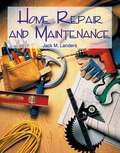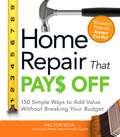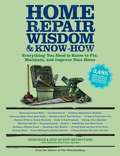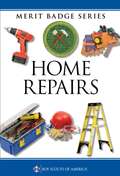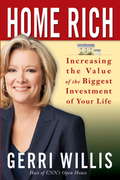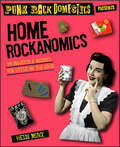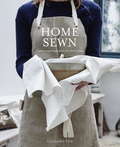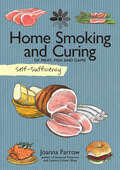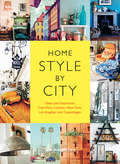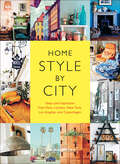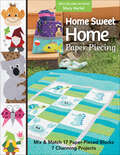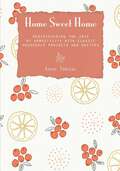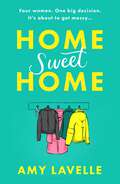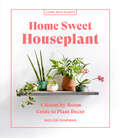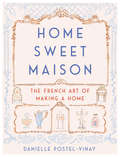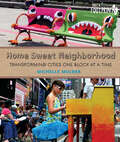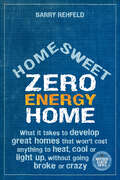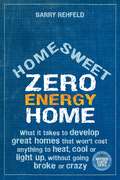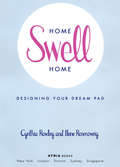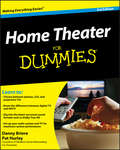- Table View
- List View
Home Repair And Maintenance
by Jack M. LandersHome Repair and Maintenance provides students with the basic information needed to safely use hand tools, power tools, and assorted building materials. <P><P>This highly illustrated text teaches students the skills and techniques used in carpentry, masonry, plumbing, electrical wiring, and other building trades, as related to home repair.
Home Repair That Pays Off
by Hector SedaHomeowners spend more than $200 million a year on home repair'but according to home repair expert Hector Seda, many of them neglect the most important repairs and spend way too much money on projects that do not pay off in the long run. From simple, critical maintenance such as caulking the bathroom and cleaning the gutters to installing the right cabinetry and updating the lighting, Seda takes you step by step through the home repair projects that will best enhance your investment. With this guide, you will learn more than 100 tasks guaranteed to add value to your home. Homeowners everywhere will find Seda's advice practical, helpful, cost-efficient, and'most important'lucrative.
Home Repair That Pays Off
by Hector SedaHomeowners spend more than $200 million a year on home repair--but according to home repair expert Hector Seda, many of them neglect the most important repairs and spend way too much money on projects that do not pay off in the long run. From simple, critical maintenance such as caulking the bathroom and cleaning the gutters to installing the right cabinetry and updating the lighting, Seda takes you step by step through the home repair projects that will best enhance your investment. With this guide, you will learn more than 100 tasks guaranteed to add value to your home. Homeowners everywhere will find Seda's advice practical, helpful, cost-efficient, and--most important--lucrative.
Home Repair That Pays Off: 150 Simple Ways to Add Value Without Breaking Your Budget
by Hector SedaHomeowners spend more than $200 million a year on home repair—but according to home repair expert Hector Seda, many of them neglect the most important repairs and spend way too much money on projects that do not pay off in the long run. From simple, critical maintenance such as caulking the bathroom and cleaning the gutters to installing the right cabinetry and updating the lighting, Seda takes you step by step through the home repair projects that will best enhance your investment. With this guide, you will learn more than 100 tasks guaranteed to add value to your home. Homeowners everywhere will find Seda’s advice practical, helpful, cost-efficient, and—most important—lucrative.
Home Repair Wisdom & Know-How: Timeless Techniques to Fix, Maintain, and Improve Your Home (Wisdom & Know-How)
by Fine HomebuildingThe latest addition to Black Dog's best-selling Wisdom and Know-How series, this complete, all-in-one, easy-to-follow resource covers everything you need to know about home repair.Home Repair Wisdom & Know-How is the essential go-to book for every project homeowners encounter, from basic wiring to kitchen renovations. Featuring step-by-step instructions from the pages of Fine Homebuilding magazine, one of the most trusted sources on home repair and construction, the nearly 1,000 pages book is organized into topics including The Basic Tool Kit, Fixing a Leaky Faucet, Stain Removal, Repairing a Wood Surface, Replacing a Toilet, Fine Points of Applying Paint, Roof Repair, Fixing Large and Small Appliances, Installing Screen Doors, Home Safety and Security, Porches and Patios, Energy Alternatives, and more.Packed with tried and true advice from leaders in the industry and hundreds of photographs, charts, and sidebars, Home Repair Wisdom & Know-How is a must-have for any homeowner.
Home Repairs (Merit Badge)
by Boy Scouts of America StaffHOME REPAIRS MERIT BADGE PAMPHLET BOY SCOUTS OF AMERICA MERIT BADGE SERIES "Enhancing our youths' competitive edge through merit badges"
Home Rich
by Gerri WillisFor most Americans, our homes are tour biggest single asset. In this book CNN anchor and personal finance editor Gerri Willis sets out twelve key rules for becoming "home rich. " Showing listeners how, from buying to renovating to selling, to get the best return on their investment.
Home Rockanomics: 54 Projects & Recipes for Style on the Edge
by Heidi MinxFeel more like a home wrecker than a home designer? Tired of 10,000 shows on HGTV that don't include decorating with spray paint or cooking for vegans? Only know the names of flowers because your tattoo artist inks them on you? Then Home Rockanomics is the book for you. Never mind Martha Stewart, we're here to share recipes from punk bands, decorating tips, and even how to make your clothing cooler!! Ms. Minx brings the online cult phenomenon Punk Rock Domestics into your living room---you know, in case you forgot to pay the cable bill or your computer bit the dust. Inside there are tips on recycling your clothing as well as recipes from members of Sick of It All, CH 3, and Flogging Molly (and so many more!). Plus, loads of home tips that can help you turn that white shoe box into a truly rock 'n' roll residence. So get ready to get inspired---it's time for DIY!
Home Security: How to Protect Your Home & Family With Security System, Cameras, Companies, Alarm & Automation
by Bob JonesAre you looking to protect your home, family, and belongings? If your answer is yes, this guide is for you Recent technological advances have made home security more accessible, more accessible, and more affordable than before Forget about paying thousands of dollars to other companies to install security systems, when you can do it yourself for a few hundred dollars Save money and make sure your family and belongings are protected You will avoid being caught by people who want to harm yours and steal your belongings This guide contains: - Types of security systems - How to set them up - How to protect your family - How to save thousands of dollars by doing it yourself
Home Sewn: Projects and Inspiration for Every Room
by Cassandra EllisTransform your home with fabric as your foundation This beautiful craft book features distinctive sewing projects dedicated to living, resting, eating, and sharing. Use quality materials--from rustic linen to leather--to create simple ottomans, pendant light shades, a voile bed skirt, and more. With dreamy lifestyle photography and ideas for every room, Home Sewn is a keepsake for the modern maker.
Home Smoking and Curing of Meat, Fish and Game: Of Meat, Fish And Game (Self-Sufficiency #7)
by Joanna FarrowMake the tastiest bacon, most delicious smoked fish, or perfectly cured salami without the need for high-tech equipment or expensive ingredients.Smoking and curing originated as ways to preserve food before the advent of tin cans, freezers and vacuum packs. Nowadays, these ancient skills are enjoying a comeback as many of us look towards a more self-sufficient and rewarding way of preparing, storing and eating our food. In this book, author Joanna Farrow explains how with some basic ingredients and equipment, you can soon be salting, curing, air-drying, and smoking a whole range of seasonal and year-round produce. With clear instructions and advice to help you get started, plus twenty-five original recipes for meat, game, and shellfish, this book will give you the confidence and know-how to begin your own experiments. What could be more delicious than home-cured bacon, subtle smoked salmon, or air-dried ham? With guides to setting up your own smoker, preparing salt and brine cures, drying, and preserving, Self-Sufficiency: Home Smoking and Curing is the perfect introduction to making the most of meat, fish, game and poultry.
Home Style by City: Ideas and Inspiration from Paris, London, New York, Los Angeles, and Copenhagen
by Ida MagntornExplore the world's most stylish and eclectic residences in this inspired armchair décor guide. Home Style by City captures the essense of five design-forward cities, featuring gorgeously decorated homes from each that reflect local style and inspire internationally. Part city tour—including must-visit flea markets, bits of colorful history, and curated lists of music, books, and films—and part design resource for achieving the various looks, this refreshing perspective on décor shows how cities themselves impact interiors. Illuminating text invites readers into page after page of lavishly photographed interiors, offering deceptively simple transitions and insider tips to bring the look into any space. Visually rich and totally inspiring, Home Style by City is a treasure for lovers of design, travel, and, of course, big city dreams.
Home Style by City: Ideas and Inspiration from Paris, London, New York, Los Angeles, and Copenhagen
by Ida Magntorn“Features five design-focused metropolises . . . and funky spaces that reflect the sensibilities of life there . . . It has visual inspiration galore.” —Refinery29Explore the world’s most stylish and eclectic residences in this inspired armchair décor guide. Home Style by City captures the essence of five design-forward cities, featuring gorgeously decorated homes from each that reflect local style and inspire internationally. Part city tour—including must-visit flea markets, bits of colorful history, and curated lists of music, books, and films—and part design resource for achieving the various looks, this refreshing perspective on décor shows how cities themselves impact interiors. Illuminating text invites readers into page after page of lavishly photographed interiors, offering deceptively simple transitions and insider tips to bring the look into any space. Visually rich and totally inspiring, Home Style by City is a treasure for lovers of design, travel, and, of course, big city dreams.“From character and cultural heritage, each section offers up tips for decorating in this eclectic-bohemian style from where to shop (flea markets) while in these cities to ‘get the look’ ideas and DIYs to create your own favorite city-inspired look.” —Poppytalk“Ida’s book is loaded with wonderful images of her friends’ stylish homes who are collectors of vintage finds. She also lists favorite flea markets, best movies to watch, books to read, and music to listen to.” —A Well Lived House
Home Sweet Home Paper Piecing: Mix & Match 17 Paper-Pieced Blocks; 7 Charming Projects
by Mary HertelPaper piece gnomes, animals, flowers, and other nature motifs with best-selling author Mary Hertel's new collection of 17 paper pieced blocks. Mix and match the new blocks into quilts, table runners, pillows, and more projects for the home. Fans of Mary Hertel admire her easy-to-follow instruction for paper piecing and the ability to mix and match blocks and projects across all of the books in Mary's bestselling series. Mary's signature style shows readers that paper piecing is fun and easy. Her approach is like sewing by number - you follow the illustrated steps and have fun watching your image emerge. Create 17 bestselling blocks and seven projects featuring gnomes, animals, and a flower. Beginner quilters will learn an easy way to paper piece, and more experienced quilters will take away techniques to improve their skills. Decorate your home with whimsical, fun projects or gift your paper-pieced creations
Home Sweet Home: Rediscovering the Joys of Domesticity with Classic Household Projects and Recipes
by Sarah TomczakIn our modern age of rampant consumerism, we are losing touch with the traditional domestic activities that previous generations took for granted. We buy everything we need—and much that we don’t—rather than making new or making do. We no longer know how to sew a button, darn a hole, or iron properly. However, while vacuum cleaners and washing machines might be a godsend, can we favorably compare a mass-produced holiday decoration from a superstore with a gorgeous home-made winter wreath?Home Sweet Home brings you 100 simple, traditional projects and advice that will reintroduce you to the joy of making things by hand and the pleasure of a home filled with individuality and charm. From making all-natural surface cleaner and removing stains to cooking the perfect Sunday roast, to laying a table and hosting a party, this sweet little book will not only help you create a cozy home but will also save you money. Today, a whole new generation is discovering the value, and pleasure, of making things for themselves, their homes, and their families.
Home Sweet Home: The most hilarious book about messy sisters you’ll read this year!
by Amy Lavelle'If you loved Fleabag, you'll love this' LAURA KEMP, on Definitely FineFour sisters. One house. It's about to get messy...Poppy, Saffron, Rosemary and Sorrell might be sisters, but they could not be more different... Oldest Poppy has hit all the milestones before turning thirty, but constantly being in control is starting to feel a bit suffocating; peacemaker Saffron will do anything to keep her sisters together even at her own expense; Rosemary has crafted a perfect façade, but cracks in her engagement are beginning to surface; youngest Sorrell is pregnant after a one-night stand, and is determined to do it all on her own for once - without any help from her sisters! But when they inherit their family home, the four must make the decision to keep or sell the house - and they're about to discover that no one gets under your skin quite like family... Can they ever put their differences aside and find a way to move forward together?Heartwarming, uplifting and hilarious, Home Sweet Home is a novel about sisters, misunderstandings and growing up. Perfect for fans of Emma Gannon, Olivia Beirne and Helly Acton.***Praise for Amy Lavelle:Funny and irreverent though the writing is, Hannah's true emotions shine through, and will strike a chord with anyone who has ever lost a loved one. - MY WEEKLYNo one ever teaches us how to grieve. That's the core message that soars through Amy Lavelle's surprisingly uplifting debut. ... This is a story that'll stay with you. - COSMOPOLITAN
Home Sweet Houseplant: A Room-by-Room Guide to Plant Decor (Living with Plants)
by Baylor ChapmanGreenify Your Home No matter what space you&’re considering—from a kitchen window to a loft-size living room—this book, adapted from Decorating with Plants, will show you how to find the perfect plant for the perfect spot. Plant designer Baylor Chapman starts with the basics, including a guide for choosing and caring for your plants, then takes the reader room by room, offering unexpected design concepts and inspired projects to elevate your home. How about four ways to turn your dresser into a style statement—urban bohemian, feminine glamour, sleek contemporary, or natural beauty?
Home Sweet Maison: The French Art of Making a Home
by Danielle Postel-VinayFrench Women Don’t Get Fat meets The Little Book of Hygge in this lively, sophisticated, and practical illustrated lifestyle guide that shows how to enjoy la belle vie—to live like the French every day—transforming your house into a home defined by beauty, family, and accessible elegance.How do the French create the elusive and alluring sanctuaries they call home? This question long intrigued Danielle Postel-Vinay. Thanks to a chance encounter with a French expat in La Crosse, Wisconsin, and years of immersive research, she embarked on a quest to discover the secrets of the French home aesthetic.Experiencing first-hand la belle vie—the beautiful life—Postel-Vinay now shows everyone how to create their own French sanctuary, a home sweet maison, no matter where they live. Providing more than just interior decorating and design tips, Postel-Vinay teaches you how to foster the warmth, beauty, and rituals inherent in the French home and create an environment better suited to living a rich, full, connected life. At the center of the book is the idea that your house should be a reflection of you, your hobbies, your family history, your rituals, all the things that make your life unique. A happy home is a home that expresses your rituals and your taste, not one that relies on prefab décor from a mass retailer.Home Sweet Maison takes a room-by-room approach to show how the French view: The Aesthetic: why the objects in your home matter, why minimalism is overrated, and why the French always choose the perfect décor for their salonsThe Practical: how to use mise-en-place, or the French art of organization, in your kitchen, and how to find the right stain-removing potions to create your own French laundryThe Sensual: the way the French employ scent in their home as a personal signatureThe Philosophical: the idea that every room in a French house has a specific purpose, and that the activity in one room should never bleed into the othersHome Sweet Maison encapsulates the very heart of the French way of seeing the world: set the table formally, adhere to all the conventions of ritual and tradition, then take pleasure in indulgence. It’s about using French concepts and routines to change our homes, our relationships, and our lives for the better.
Home Sweet Neighborhood: Transforming Cities One Block at a Time (Orca Footprints #15)
by Michelle MulderPlacemaking—personalizing public and semi-private spaces like front yards—is a growing trend in cities and suburbs around the world, drawing people out of their homes and into conversation with one another. Picture a busy avenue. Now plant trees along the boulevard, paint a mural by the empty lot, and add a community garden. Set up benches along the sidewalks and make space for kids' chalk drawings, and you've set the scene for a thriving community. Kids are natural placemakers, building tree forts, drawing on sidewalks and setting up lemonade stands, but people of all ages can enjoy creative placemaking activities. From Dutch families who drag couches and tables onto sidewalks for outdoor suppers to Canadians who build little lending libraries to share books with neighbors, people can do things that make life more fun and strengthen neighborhoods. Home Sweet Neighborhood combines upbeat text, fun facts and colorful photos to intrigue and inspire readers. The epub edition of this title is fully accessible.
Home Sweet Rented Home: Transform Your Home Without Losing Your Deposit
by Medina Grillo'So many useful tips in here - this is so different to most other books out there!' - Alex Stedman, The Frugality'There seems to be no end of resourceful, affordable and creative ideas.' - Sophie RobinsonYou've got the keys from your landlord, moved into your new home, and the boxes are unpacked. Now you want to put your stamp on the place, but how do you do this when you can't paint the walls, refurbish the kitchen or replace the old, tired flooring?And can you really live with magnolia walls? What about those outdated kitchen cupboards? Not to mention the tattered lampshades, old sofa and sparse furniture...In this invaluable book, award-winning interiors blogger Medina Grillo shares her favourite tips, tricks and DIY projects for transforming a rented space. Discover ways to add a splash of colour with removable wallpaper, learn how to hang artworks without damaging the walls, and turn your hand to upcycling those furniture bargains you picked up at the flea market. With chapters covering all aspects of the home, from walls, flooring and lighting to storage and accessories, Home Sweet Rented Home will enable every reader to make their house feel like home, whether they are a DIY expert or have never before lifted a paintbrush. Filled with photography and illustrations, it is the perfect read for any renter looking to live in a beautiful and stylish home.
Home Sweet Rented Home: Transform Your Home Without Losing Your Deposit
by Medina GrilloYou've got the keys from your landlord, moved into your new home, and the boxes are unpacked. Now you want to put your stamp on the place, but how do you do this when you can't paint the walls, refurbish the kitchen or replace the old, tired flooring?And can you really live with magnolia walls? What about those outdated kitchen cupboards? Not to mention the tattered lampshades, old sofa and sparse furniture...In this invaluable book, award-winning interiors blogger Medina Grillo shares her favourite tips, tricks and DIY projects for transforming a rented space. Discover ways to add a splash of colour with removable wallpaper, learn how to hang artworks without damaging the walls, and turn your hand to upcycling those furniture bargains you picked up at the flea market. With chapters covering all aspects of the home, from walls, flooring and lighting to storage and accessories, Home Sweet (Rented) Home will enable every reader to make their house feel like home, whether they are a DIY expert or have never before lifted a paintbrush. Filled with photography and illustrations, it is the perfect read for any renter looking to live in a beautiful and stylish home.
Home Sweet Zero Energy Home (Mother Earth News Books for Wiser Living)
by Barry RehfeldZero energy homes produce at least as much energy as they consume through a combination of energy efficiencies, passive design and renewable energy production. California has adopted zero net energy as the new residential standard for 2020; many other governments are considering similar policies. Developing zero energy homes is the first step towards making all buildings zero energy — a critical step in mitigating climate change, since buildings account for 40% of material and energy use worldwide.Home Sweet Zero Energy Home is the first practical guidebook that clearly shows how zero energy homes can be good, livable, affordable homes. The author identifies all the pieces of the zero energy puzzle and how they fallinto place, and explains how homeowners and buyers can also take smaller steps towards sharply reducing the energy use of existing buildings. Focusing on real costs and savings, this book takes an in depth look at:Site selection and passive designInsulation, windows, doors and building materialsHeating and coolingAppliances and electronicsFinancial resources and incentives.Whether you are a prospective buyer, owner, or developer, Home Sweet Zero Energy Home is your complete guide to creating a more comfortable, efficient, environmentally friendly home without breaking your back or yourbank account.
Home Sweet Zero Energy Home: What It Takes to Develop Great Homes That Won't Cost Anything to Heat, Cool or Light Up, without Going Broke or Crazy
by Barry RehfeldZero energy buildings produce at least as much energy as they consume through a combination of efficiency design and renewable technologies. Home sweet zero energy home shows how developing a better more environmentally friendly home doesn't have to break your back or your bank account.
Home Swell Home
by Cynthia Rowley Ilene RosenzweigUsing the same friendly tone and wry wit as in their first book, Rowley and Rosenzweig introduce the idea of haute decor, explaining how to make outfitting a home as exciting and accessible as buying a whole new wardrobe.
Home Theater For Dummies
by Danny Briere HurleyOverwhelmed with big screen TV and home theater audio options? What do you need to build the perfect home theater experience? Home Theater For Dummies, 3rd Edition shows you how to plan a home theater system and choose components that fit your budget and your room.Beginning with the most basic information, this guide helps you choose what you need and put it all together. It explains DLP, 3LCD, HDMI, DTV, and HDTV so you can talk intelligently with salespeople at the electronics store. You'll find out about Blu-ray, explore HD and satellite radio options, and see how to incorporate a Wii, Xbox, or Playstation 3 into your set-up. Learn to:Choose among plasma, LCD, and projection TVsKnow the difference between digital TV and HDTVAssess and choose an LCD TV, a new 3D TV, or an HD radioSet up your audio system and TV for maximum performanceUse a Media Center or Home Theater PCFine-tune your system and add cool touches such as accessing home theater content from your cell phoneExplore HD and satellite radio options, CD players, DVD-Audio disks, and options for old cassettes and vinylSet up your system with the proper cables for each component, or learn what it takes to go wirelessCalibrate your video with a calibration disk, an optical comparator, or a DVD containing THX OptimizerGet the perfect home theater experience by following the expert tips and techniques presented in Home Theater For Dummies, 3rd Edition. You'll be watching movies and listening to audio in no time!
